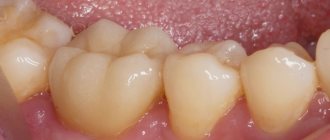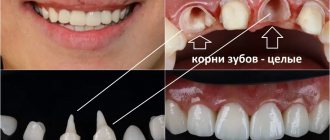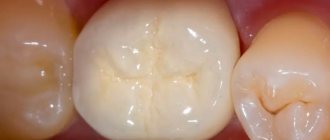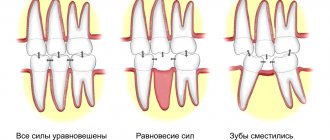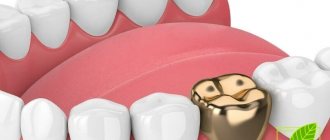Many patients of orthopedic dentists after prosthetics talk about how difficult it was for them to get used to dentures. High-quality permanent artificial teeth and crowns are compact in size and do not cause any discomfort. But with removable ones, problems arise: from unpleasant sensations in the palate and irritating pressure on the gums to constant nausea and even a gag reflex. Each patient experiences the adaptation process in his own way, so it can last only a couple of days, one or two weeks, or several months.
Why does discomfort occur?
A person with missing teeth gets used to living without them. His dental system begins to distribute the chewing load differently, and the muscles, cheeks, nerves, tongue and jaw bones involved in the process gradually get used to the restructuring that has occurred.
If missing teeth can be restored with permanent dentures, the parameters of which are almost identical to natural teeth, the load when chewing food turns out to be natural. And the absence of foreign elements - fixing hooks and staples - guarantees the absence of irritation of the mucous membranes of the cheeks and tongue.
In removable structures, the chewing load is distributed differently. For example, popular clasp dentures distribute it to the palate and the remaining adjacent teeth. It is clear that the sensations when chewing food will be unusual at first and will almost certainly cause irritation.
Probable Causes
Let's look at several factors that could cause gum problems:
- Poor preparation. Before fixing the crown, the doctor must carefully prepare the teeth: remove the nerve and conduct a thorough cleaning. If any procedure was not carried out under sterile conditions, an infection may enter the soft tissue.
- Inappropriate design. If the dental crown does not match the size of the natural tooth, sooner or later this will lead to rubbing of the mucous membrane. Constant friction will provoke an inflammatory process.
- Exceeding the service life. The average lifespan of crowns is from 5 to 10 years, depending on the material from which the product is made. After the set period, gaps form and the product no longer fits tightly to the tooth. As a result, micro food particles become clogged in the holes, which leads to rotting and inflammation.
- Inadequate dental care. If you do not follow basic hygiene rules, this can result in various complications, including gum disease.
What inconveniences can you encounter after prosthetics?
Dentists installing dentures in Moscow warn in advance about possible discomfort that may manifest itself:
- noticeably irritating sensation of a foreign body in the oral cavity;
- pain caused by the pressure of the structure on the supporting teeth and especially the gums;
- rubbing of mucous membranes, redness and swelling, formation of bedsores on the gums;
- a feeling of poor closure of the jaws and teeth;
- increased salivation caused by the perception of the prosthesis as food that needs to be easier to move from the mouth to the throat;
- the appearance of gagging as a reaction to the presence of a foreign body in the mouth;
- impaired diction, which can be caused by even the best removable dentures (the tongue needs time to get used to changing position when pronouncing sounds);
- partial loss of taste of products caused by the closure of certain areas of the oral mucosa by the prosthesis.
What to do if a tooth hurts under a denture?
If toothache occurs after dentures, the first priority is to identify the cause as soon as possible and apply appropriate therapeutic measures. This problem will not resolve on its own, and any home remedies will not be effective. Therefore, do not wait and contact your dentist for professional help.
If the dentist discovers a tooth infection under the crown, he or she may recommend root canal treatment, which usually requires removal of the denture. In some cases, a hole can be drilled into the crown, allowing the dentist to access the root canal without having to remove and install another crown. This is a complex operation, but it will save you money since the removed crowns are often no longer reusable.
Do you really have to put up with this?
Making dentures is quite a complex job, in some ways even comparable to art. Working in tandem, the orthopedic surgeon and the dental technician put a lot of effort into making an accurate and as comfortable prosthesis as possible. But in most cases, after putting it on and wearing it, it turns out that it needs some adjustment to the patient’s gums.
To regain lost comfort, you need to walk with the installed structure for 3–4 weeks. During this time, you can get used to the initially interfering prosthesis and get rid of the unpleasant sensations. If you simply remove it when discomfort appears, then you will have to describe all the inconveniences experienced in words, and the doctor will not be able to understand what exactly caused them. Do you want the correction to be effective? Be sure to come to your appointment wearing a prosthesis that causes discomfort.
Correction of dentures is carried out within 15–20 minutes. As a rule, it is possible to restore the patient’s comfort in one or two visits to the dental clinic.
What can you use?
To cope with pain, you can use different means.
- Use soda (1 half teaspoon) diluted in warm water (1 glass), it is advisable to add a couple of drops of an alcohol solution of iodine. Rinse your mouth every twenty minutes until the pain subsides completely.
- If the gums under the crown are inflamed, take a pain reliever with an anti-inflammatory effect.
- In the pharmacy you can find special gels, for example, Metrogyl Denta. They will not allow germs to multiply, and the cooling effect will relieve pain.
Methods of tissue trimming: after which procedures pain occurs more often
There are different ways to prepare tissue. According to experts, after grinding the teeth, some of them may actually experience aching pain. But other methods, on the contrary, are considered gentle, and therefore do not cause discomfort at any stage of treatment and prosthetics.
Using a diamond-tipped bur
The drill, despite the loud, annoying sound, is still popular among dentists, because with its help you can quickly and efficiently carry out work of any level of complexity and scale, and grind off any amount of tissue.
It is boron that is most often used for preparing tissue for crowns and bridges, and for turning teeth for veneers. During the process, the doctor uses the device at different speeds so that it does not cause overheating of the tissues and pulp; at the same time, a cooling liquid is supplied to the oral cavity. Despite all the safety measures, many patients note that it was after using boron that they experienced pain.
Via ultrasound
Situations where a tooth hurts after grinding performed using ultrasound are quite rare. The method is characterized by a more gentle effect, compared to boron[1], allows you to process fabrics carefully and without contact, and does not cause overheating. However, ultrasound can still cause discomfort and short-term increased sensitivity of hard tissues and gums in people with a low pain threshold and weakened enamel.
The method is used if you need to remove a small amount of tissue.
Laser method
Here, a laser is used for preparation, which, like ultrasound, acts in a targeted and non-contact manner. The method is considered one of the safest and most painless[2], suitable for people with sensitive gums and mucous membranes, and does not cause pain or discomfort. The laser not only carefully grinds the tissues, but also disinfects them, promotes rapid healing, and prevents bleeding.
Water-abrasive treatment
Suitable only in cases where a minimum amount of tissue needs to be removed. During the process, a specialist treats the enamel with a stream of water containing abrasive particles. After such grinding of teeth, aching pain and any discomfort are completely excluded.
On a note! Until recently, dentistry also used a chemical method, where tissues were first softened using chemicals and then removed with an instrument. However, today this method is recognized as traumatic and very dangerous for the nerve of the tooth.
Why does my gum hurt?
Sometimes the teeth do not react at all, but the gums hurt after grinding. Let's list the reasons for this:
- physiological reaction to an anesthetic injection,
- gum retraction: in order to qualitatively fit the prosthesis to the soft tissues and eliminate discomfort during operation, as well as to create a highly accurate design that fully corresponds to all the anatomical features of the patient, before taking impressions, specialists widen the periodontal sulcus. For the procedure, special threads are most often used, which are inserted under the gum and lift it. Such manipulations lead to the fact that the gums then become slightly inflamed and swollen, and also hurt for several days,
- individual reaction of the patient and allergies to the medications used during the grinding process: in this case, the gums may itch and itch, a rash appears on them,
- traumatic gingivitis and periodontitis: if in the process the specialist damaged the gums, then the patient experiences persistent aching pain, swelling and bleeding of the mucous membrane. As a rule, it all starts with gingivitis, but if the disease is neglected, it is complicated by periodontitis.
Causes of painful sensations in teeth
1. Physiological response to intervention
This is the most common reason why teeth and gums hurt after grinding for crowns and other orthopedic structures. After all, during the procedure, the specialist acts on the tissue instrumentally and medicinally, touching the nerve endings. This reaction is considered normal.
On a note! If, after grinding teeth, hyperesthesia (increased sensitivity) and aching pain appear, especially during the consumption of cold, hot, sour and spicy foods, and hygienic cleaning, then this often simply indicates a thinning of the tissue area of the prepared unit.
Most often, hyperesthesia after turning occurs on vital, that is, living units where the pulp is preserved. Sensitivity is enhanced even despite the presence of temporary crowns, which, it would seem, serve as reliable protection from external irritants. Temporary structures are fixed immediately after preparation and worn until permanent dentures are created.
Medical errors
If a tooth or gum hurts after grinding, then unqualified actions by the doctor cannot be ruled out. Most often, inexperienced specialists make the following mistakes:
- overheating of the pulp: occurs when preparing tissue with a bur,
- removing too much tissue,
- nerve injury: to avoid complications associated with damage, overheating or inflammation of the nerve under the prosthesis, experienced specialists advise depulping the tooth, that is, first removing the pulp from it.
If the doctor made the mistakes listed above, then the pain makes itself felt almost immediately after the procedure and can persist for several weeks or even months.
3. Development of a pathological inflammatory process
If a lot of time has passed after medical manipulations, and you have severe discomfort and your teeth hurt after grinding for crowns and bridges, then this signals the development of various dental diseases: caries, pulpitis, periodontitis, cyst, granuloma, fistula, abscess, gumboil. In this case, the pain does not go away for a long time, intensifies with each subsequent day, and is poorly relieved by analgesics. Along the way, other alarming symptoms arise: purulent bumps appear on the gums, the gums and cheek swell, the body temperature rises, it becomes painful to chew and press on the causative element.
More often, the problem arises again due to the fault of a clinic specialist who, during the preparation and preparation of tissues before prosthetics, violated the rules of asepsis, did not fully treat (after all, dentures are often placed on teeth destroyed by deep caries and other dental diseases), poorly cleaned and poorly sealed the roots channels. Pulpitis can occur if, in the process of preparing the “support,” the doctor caused irreversible damage to the nerve.
Expert opinion
Andrey Rastislavovich Chernov
Specializations: Orthopedic dentist
Experience: 11+
“Treatment, grinding and prosthetics of a tooth with an orthopedic design is a complex and multi-stage process, in which at least several experienced specialists must take part - a therapist, a dental technician (creates a prosthesis using casts of the jaws), an orthopedic doctor. If everyone has done their job efficiently, then pain after completing all the manipulations should not arise either in the short or long term.”
Sometimes a pathological inflammatory process occurs due to the fault of a patient who systematically violates oral hygiene, does not monitor the condition of installed dentures and surrounding tissues, and receives various injuries.
